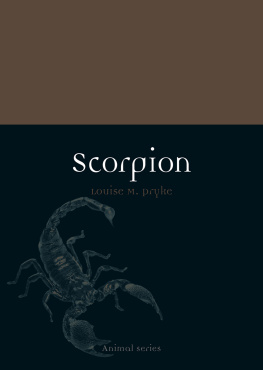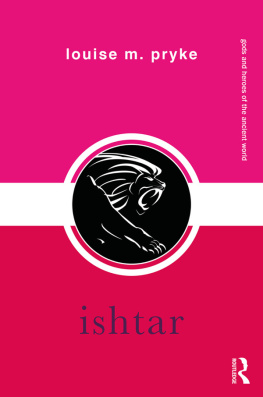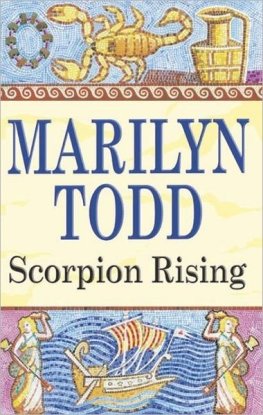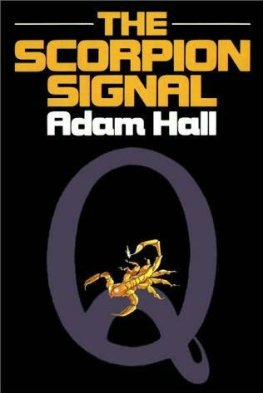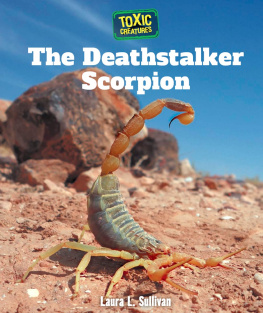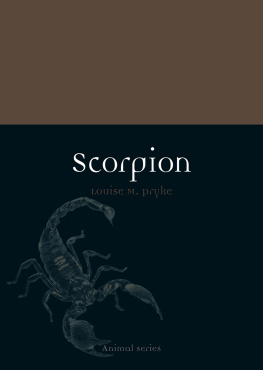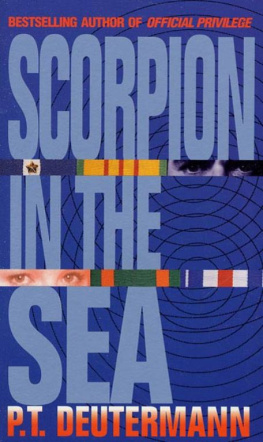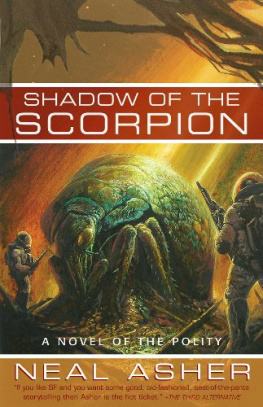Louise M. Pryke - Scorpion
Here you can read online Louise M. Pryke - Scorpion full text of the book (entire story) in english for free. Download pdf and epub, get meaning, cover and reviews about this ebook. year: 2016, genre: Romance novel. Description of the work, (preface) as well as reviews are available. Best literature library LitArk.com created for fans of good reading and offers a wide selection of genres:
Romance novel
Science fiction
Adventure
Detective
Science
History
Home and family
Prose
Art
Politics
Computer
Non-fiction
Religion
Business
Children
Humor
Choose a favorite category and find really read worthwhile books. Enjoy immersion in the world of imagination, feel the emotions of the characters or learn something new for yourself, make an fascinating discovery.
- Book:Scorpion
- Author:
- Genre:
- Year:2016
- Rating:5 / 5
- Favourites:Add to favourites
- Your mark:
- 100
- 1
- 2
- 3
- 4
- 5
Scorpion: summary, description and annotation
We offer to read an annotation, description, summary or preface (depends on what the author of the book "Scorpion" wrote himself). If you haven't found the necessary information about the book — write in the comments, we will try to find it.
Scorpion — read online for free the complete book (whole text) full work
Below is the text of the book, divided by pages. System saving the place of the last page read, allows you to conveniently read the book "Scorpion" online for free, without having to search again every time where you left off. Put a bookmark, and you can go to the page where you finished reading at any time.
Font size:
Interval:
Bookmark:

Scorpion

Animal
Series editor: Jonathan Burt
Already published
Albatross Graham Barwell Ant Charlotte Sleigh Ape John Sorenson
Badger Daniel Heath Justice Bear Robert E. Bieder Bee Claire Preston Beetle Adam Dodd Beaver Rachel Poliquin Bison Desmond Morris
Camel Robert Irwin Cat Katharine M. Rogers Chicken Annie Potts Cockroach Marion Copeland Cow Hannah Velten Crocodile Dan Wylie Crow Boria Sax
Deer John Fletcher Dog Susan McHugh Dolphin Alan Rauch Donkey Jill Bough Duck Victoria de Rijke
Eagle Janine Rogers Eel Richard Schweid Elephant Dan Wylie
Falcon Helen Macdonald Flamingo Caitlin R. Kight Fly Steven Connor Fox Martin Wallen Frog Charlotte Sleigh
Giraffe Edgar Williams Goat Joy Hinson Gorilla Ted Gott and Kathryn Weir Guinea Pig Dorothy Yamamoto
Hare Simon Carnell Hedgehog Hugh Warwick Horse Elaine Walker Hyena Mikita Brottman
Kangaroo John Simons
Leech Robert G. W. Kirk and Neil Pemberton Leopard Desmond Morris Lion Deirdre Jackson Lobster Richard J. King
Monkey Desmond Morris Moose Kevin Jackson Mosquito Richard Jones Moth Matthew Gandy Mouse Georgie Carroll
Octopus Richard Schweid Ostrich Edgar Williams Otter Daniel Allen Owl Desmond Morris Oyster Rebecca Stott
Parrot Paul Carter Peacock Christine E. Jackson Penguin Stephen Martin Pig Brett Mizelle Pigeon Barbara Allen
Rabbit Victoria Dickenson Rat Jonathan Burt Rhinoceros Kelly Enright
Salmon Peter Coates Scorpion Louise M. Pryke Seal Victoria Dickenson Shark Dean Crawford Sheep Philip Armstrong Skunk Alyce Miller Snail Peter Williams Snake Drake Stutesman Sparrow Kim Todd Spider Katarzyna and Sergiusz Michalski Swallow Angela Turner Swan Peter Young
Tiger Susie Green Tortoise Peter Young Trout James Owen
Vulture Thom van Dooren
Walrus John Miller and Louise Miller Whale Joe Roman Wolf Garry Marvin
Louise M. Pryke
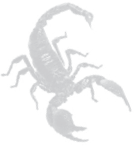
REAKTION BOOKS
To my nephew, Darcy Gordon Jones, the Little Scorpio
Published by
REAKTION BOOKS LTD
Unit 32, Waterside
4448 Wharf Road
London N1 7UX, UK
www.reaktionbooks.co.uk
First published 2016
Copyright Louise M. Pryke 2016
All rights reserved
No part of this publication may be reproduced, stored in a retrieval system or transmitted, in any form or by any means, electronic, mechanical, photocopying, recording or otherwise, without the prior permission of the publishers
Page references in the Photo Acknowledgements and
Index match the printed edition of this book.
Printed and bound in China by 1010 Printing International Ltd
A catalogue record for this book is available from the British Library
eISBN: 9781780236254

Black scorpion.
Since ancient times, scorpions have captured the imagination of humans. While scorpions and humans have coexisted for thousands of years, the image of the scorpion retains a sense of mystery and danger. In art, media and myth, the small yet distinctively statured scorpion is often depicted as having a ferocious and uncompromising nature. The Carthaginian author Tertullian (c. 160225 CE) provided this description:
So this is the scorpion, its row of knots forming a delicate, poisonous vein imbued with venom on the inside, rising up in a curved assault, it draws its barbed spear to its full height, in the manner of a war machine.
Tertullian gives this account while explaining how the Roman catapult, Scorpion, received its name. The Scorpion was a piece of Roman artillery that could be operated by one person, yielding a powerfully destructive result over a range as great as 400 m (1,300 ft). The Scorpion catapults imposing sizetoimpact ratio gives an insight into the perception of its namesake animal. Yet, despite the scorpions hostile reputation, most are not aggressive. They are generally nocturnal by nature, so the scorpion hides in burrows and crevices during the day, staying away from the light. Black scorpion.
Scorpions are exceptional and diverse creatures. One of their most impressive aspects is the ability to adapt to changing habitats. Recent studies have discovered that some species of scorpion can survive even under extreme environmental conditions. Their toughness is legendary scorpions have been shown to be able to survive freezing temperatures and submersion in water for up to two days. In drier habitats, some have been known to last for twelve months without food. Further, they are known to be one of the few creatures able to withstand ionizing radiation at nuclear test sites. In many ways, these small arthropods can be considered to be super-adapters, surviving for hundreds of millions of years with very few changes to their form, and populating every continent with the exception of Antarctica.
The relationship between humans and scorpions has been a complicated one since the earliest records, perhaps unsurprisingly given the wide territorial spread of both species. While less than 1 per cent of known scorpion species have venom capable of killing humans, the hazardous aspect of the scorpion dominates its image. Scorpions inspire fear and fascination in inverse proportion to their diminutive size. This is not without reason even in modern times, scorpion stings are a genuine public health issue in many underdeveloped tropical and subtropical countries. More than 1.2 million people per year are estimated to be stung by scorpions, resulting in over 3,000 deaths. In recent times, the perilous relationship between humans and scorpions has intensified for the scorpion, with several species in danger of extinction.
The focus of this book is the relationship between humans and scorpions, from ancient times to the modern world. While scorpions are often depicted fearsomely, there is a great diversity of human reactions to scorpions in various cultures and at different times in history. Scorpions have held revered roles in religious cult and ritual, and are frequently depicted as playing a protective role for people, gods or the natural environment. It seems fitting that this survivor from prehistoric times is featured in some of our most ancient works of myth and literature. Images of scorpions appear in some of the worlds oldest written records, including cave paintings. A hybrid creature, part human and part scorpion, plays a guardians role in the worlds oldest literary epic, the Mesopotamian Epic ofGilgamesh. Scorpion imagery appears in artistic works as diverse as Shakespeares tragedy Macbeth and the video game franchise Mortal Kombat. From ancient Egypt to modern films, the scorpion can be seen to have lasting links to kingship in human thought. The scorpions habit of carrying its young on its back is likely to be the cause of the animals perceived link to motherhood although the mother scorpions occasional behaviour of eating its young makes this connection a little surprising!
Font size:
Interval:
Bookmark:
Similar books «Scorpion»
Look at similar books to Scorpion. We have selected literature similar in name and meaning in the hope of providing readers with more options to find new, interesting, not yet read works.
Discussion, reviews of the book Scorpion and just readers' own opinions. Leave your comments, write what you think about the work, its meaning or the main characters. Specify what exactly you liked and what you didn't like, and why you think so.

